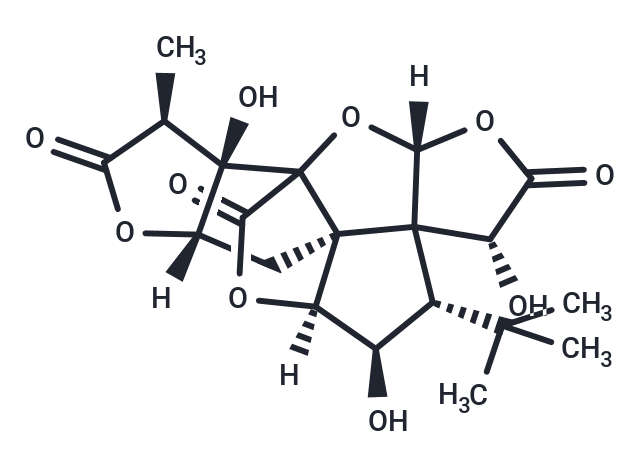Shopping Cart
Remove All Your shopping cart is currently empty
Your shopping cart is currently empty
Ginkgolide J (BN 52024) has neuroprotective activity, it can prevent A beta(1-42) induced inhibition of long-term potentiation in the CA1 region of mouse hippocampal slices.

| Pack Size | Price | USA Warehouse | Global Warehouse | Quantity |
|---|---|---|---|---|
| 1 mg | $55 | In Stock | In Stock | |
| 5 mg | $132 | In Stock | In Stock | |
| 10 mg | $195 | In Stock | In Stock | |
| 25 mg | $329 | In Stock | In Stock | |
| 50 mg | $473 | In Stock | In Stock | |
| 100 mg | $648 | - | In Stock | |
| 200 mg | $873 | - | In Stock | |
| 1 mL x 10 mM (in DMSO) | $163 | In Stock | In Stock |
| Description | Ginkgolide J (BN 52024) has neuroprotective activity, it can prevent A beta(1-42) induced inhibition of long-term potentiation in the CA1 region of mouse hippocampal slices. |
| In vitro | A new Ginkgo biloba extract P8A (TTL), 70% enriched with terpene trilactones, prevents A beta induced inhibition of long-term potentiation in the CA1 region of mouse hippocampal slices. This neuroprotective effect is attributed in large part to Ginkgolide J that completely replicates the effect of the extract. Ginkgolide J is also capable of inhibiting cell death of rodent hippocampal neurons caused by A beta[1]. |
| Cell Research | Hippocampal cultures were treated by adding 10 μM Aβ1-42 in its oligomeric form with or without P8A, or alternatively with and without each of the individual ginkgolides and bilobalide (GA, GB, GC GJ, BB).??these compounds were dissolved in DMSO and added to the culture medium at a ratio of 1:1000 (v/v), yielding a 0.1% DMSO solution.?After 24 hrs the number of viable cells was assessed by nuclear counting.?In a separate set of experiments, viable cells were counted by using the ethidium homodimer/calcein-AM combination of vital dyes (LIVE/DEAD Viability/Cytotoxicity Kit for mammalian cells;?Invitrogen), according to the manufacturer instructions.?Values represent the mean SEM of three consecutive experiments.?Each experiment was performed in triplicate[1]. |
| Synonyms | BN 52024, 7-beta-Hydroxyginkgolide A |
| Molecular Weight | 424.40 |
| Formula | C20H24O10 |
| Cas No. | 107438-79-9 |
| Smiles | [H][C@]12C[C@]34[C@]5([H])OC(=O)C3(O[C@]3([H])OC(=O)[C@H](O)C43[C@@H]([C@H]5O)C(C)(C)C)[C@@]1(O)[C@H](C)C(=O)O2 |
| Relative Density. | 1.64 g/cm3 |
| Storage | Powder: -20°C for 3 years | In solvent: -80°C for 1 year | Shipping with blue ice/Shipping at ambient temperature. | |||||||||||||||||||||||||||||||||||
| Solubility Information | DMSO: 60.00 mg/mL (141.38 mM), Sonication is recommended. | |||||||||||||||||||||||||||||||||||
| In Vivo Formulation | 10% DMSO+40% PEG300+5% Tween 80+45% Saline: 2.00 mg/mL (4.71 mM), Sonication is recommended. Please add the solvents sequentially, clarifying the solution as much as possible before adding the next one. Dissolve by heating and/or sonication if necessary. Working solution is recommended to be prepared and used immediately. The formulation provided above is for reference purposes only. In vivo formulations may vary and should be modified based on specific experimental conditions. | |||||||||||||||||||||||||||||||||||
Solution Preparation Table | ||||||||||||||||||||||||||||||||||||
DMSO
| ||||||||||||||||||||||||||||||||||||
| Size | Quantity | Unit Price | Amount | Operation |
|---|

Copyright © 2015-2025 TargetMol Chemicals Inc. All Rights Reserved.